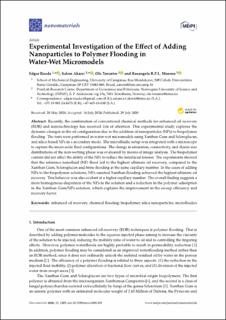| dc.contributor.author | Rueda, Edgar | |
| dc.contributor.author | Akarri, Salem Saeed Fadhl | |
| dc.contributor.author | Torsæter, Ole | |
| dc.contributor.author | Moreno, Rosangela B.Z.L. | |
| dc.date.accessioned | 2022-05-10T08:41:17Z | |
| dc.date.available | 2022-05-10T08:41:17Z | |
| dc.date.created | 2020-07-30T09:24:28Z | |
| dc.date.issued | 2020 | |
| dc.identifier.citation | Nanomaterials. 2020, 10 (1489), 1-21. | en_US |
| dc.identifier.issn | 2079-4991 | |
| dc.identifier.uri | https://hdl.handle.net/11250/2994979 | |
| dc.description.abstract | Recently, the combination of conventional chemical methods for enhanced oil recovery (EOR) and nanotechnology has received lots of attention. This experimental study explores the dynamic changes in the oil configuration due to the addition of nanoparticles (NPs) to biopolymer flooding. The tests were performed in water-wet micromodels using Xanthan Gum and Scleroglucan, and silica-based NPs in a secondary mode. The microfluidic setup was integrated with a microscope to capture the micro-scale fluid configurations. The change in saturation, connectivity, and cluster size distributions of the non-wetting phase was evaluated by means of image analysis. The biopolymer content did not affect the ability of the NPs to reduce the interfacial tension. The experiments showed that the reference nanofluid (NF) flood led to the highest ultimate oil recovery, compared to the Xanthan Gum, Scleroglucan and brine flooding at the same capillary number. In the cases of adding NPs to the biopolymer solutions, NPs-assisted Xanthan flooding achieved the highest ultimate oil recovery. This behavior was also evident at a higher capillary number. The overall finding suggests a more homogenous dispersion of the NPs in the solution and a reduction in the polymer adsorption in the Xanthan Gum/NPs solution, which explains the improvement in the sweep efficiency and recovery factor. | en_US |
| dc.language.iso | eng | en_US |
| dc.publisher | MDPI | en_US |
| dc.rights | Navngivelse 4.0 Internasjonal | * |
| dc.rights.uri | http://creativecommons.org/licenses/by/4.0/deed.no | * |
| dc.subject | Reservoarteknikk | en_US |
| dc.subject | Reservoir Engineering | en_US |
| dc.title | Experimental investigation of the effect of adding nanoparticles to polymer flooding in water-wet micromodels | en_US |
| dc.title.alternative | Experimental investigation of the effect of adding nanoparticles to polymer flooding in water-wet micromodels | en_US |
| dc.type | Peer reviewed | en_US |
| dc.type | Journal article | en_US |
| dc.description.version | publishedVersion | en_US |
| dc.subject.nsi | VDP::Petroleumsteknologi: 512 | en_US |
| dc.subject.nsi | VDP::Petroleum engineering: 512 | en_US |
| dc.source.pagenumber | 1-21 | en_US |
| dc.source.volume | 10 | en_US |
| dc.source.journal | Nanomaterials | en_US |
| dc.source.issue | 1489 | en_US |
| dc.identifier.doi | 10.3390/nano10081489 | |
| dc.identifier.cristin | 1821011 | |
| dc.relation.project | Norges forskningsråd: 262644 | en_US |
| cristin.ispublished | true | |
| cristin.fulltext | original | |
| cristin.qualitycode | 1 | |

